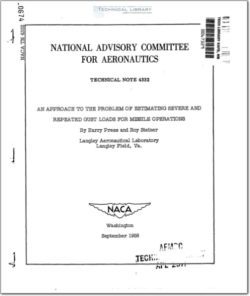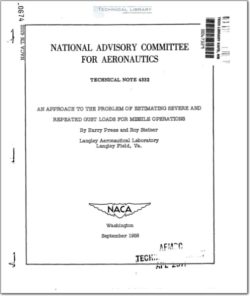NACA-TN-4332

- Version
- 322 Downloads
- 1.46 MB File Size
- 1 File Count
- December 4, 2015 Create Date
- December 4, 2015 Last Updated
National Advisory Committee for Aeronautics, Technical Notes - Estimating Severe and Repeated Gust Loads for Missile Operations

An analysis of available airplane measurements of vertical gust
velocity is presented in order to arrive at a simple description of the
frequency and intensity of gust velocities experienced by airplanes in
operations. For the purpose of application to missile_operations, the
results obtained are modified to eliminate the effects of storm-avoidance
procedures normally followed in airplane operations. The frequency dis—
tributions of gust velocity are then converted to a form appropriate for
use in power spectral response calculations. Methods of applying the
results to the estimation of the large and the small repeated loads in
missile operations are then developed. Simple methods of estimating the
gust loadings that will be exceeded with a given probability are pre—
sented in terms of missile response parameters and turbulence parameters.
The limitations of the present results are also discussed briefly.
The effects of atmospheric turbulence on airplane structural loads
have been of concern for many years. Recently, it has become increas-
ingly clear that certain types of missiles and unmanned vehicles are
also sensitive to turbulence in regard to structural loading and control
problems. It is the purpose of the present paper to extend recent results
on the estimation of gust loads for airplane operations (refs. 1 and 2)
to the case of missile operations. In reference 1, initial descriptions
of the frequency and intensity of atmospheric turbulence and their vari-
ation with altitude were derived in terms of discrete or derived gust
velocities, and methods of applying these data to load calculations for
airplane operations were presented. More recently the development of
random-process applications to gust response problems has, in turn, led
to efforts to utilize these data in order to establish an appropriate
description of the turbulence environment and a procedure for response
calculations in terms of the power spectra of turbulence (ref. 2). This
procedure provides a more realistic representation of the turbulence
field and furthermore is more suitable to the treatment of missile sta—
bility and elastic dynamics.
| File | Action |
|---|---|
| naca-tn-4332.pdf | Download |

Comment On This Post